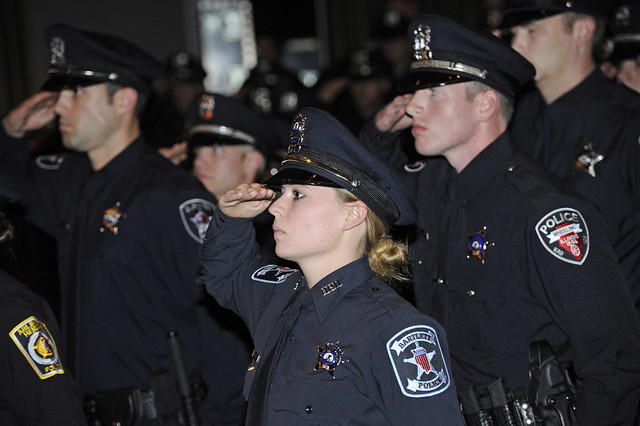Widgetized Section
Go to Admin » Appearance » Widgets » and move Gabfire Widget: Social into that MastheadOverlay zone
Where Are the Female Law Enforcement Officers?
The views expressed are those of the author and do not necessarily reflect the views of ASPA as an organization.
By Donal A. Hardin
March 31, 2015
A plethora of descriptions and opinions may immediately come to mind. But the research and data makes something very clear regarding public safety policy, policing performance and female representation in law enforcement.
There aren’t enough.
According to the most recent Bureau of Justice Statistics census of state and local police departments, only 11.9 percent of police officers in America are women. Although this represents a continuing increase –up from only 7.6 percent in 1987- the data show that most of this progress is centered in larger agencies in cities with 250,000 residents or more. In every category of population size, female police representation decreases proportional to population. Why?
Research compiled by the National Center for Women in Policing has consistently shown that women are just “as competent as their male counterparts,” rank higher in evaluations of community oriented policing values, register fewer complaints and instances of using excessive force, and provide perspective that management can utilize to improve organizational culture and policies related to family leave time, recruitment and training. So what accounts for such a small percentage of females in policing?
Some of this is no doubt an individual career choice. But that certainly does not explain the entire disparity. Nor do the perceptions and realities of policing as a militaristic, aggressive, male-dominated profession serve as a welcoming call for potential female candidates. Recounting her own experiences, one former officer I spoke to referenced the 5’-7” height requirement that existed before the early 1980s. Preemptively disqualifying most women, this barrier was eventually removed but her department was still poorly prepared to accommodate a gender integrated police force. “They didn’t even have clothing that fit me,” she recalled, forcing her to tie a men’s shirt around her back and earning her the nickname “pockets.” She also identified the lingering and unsupported emphasis on upper body strength as a barrier that still dissuades many women from pursuing a career in policing. “Guys wouldn’t ride with me,” due to her size and gender. And, even more strangely, male officers were afraid their wives would get angry with them for riding around with a female partner all night. Despite wanting to become a police officer for the same reason as her male counterparts (catching criminals, making communities safer and protecting the innocent), access to specialized positions like K-9 and SWAT were non-existent. She was even asked by one captain to pull her K-9 application specifically because of gender. Yet on the job, she “hardly had any citizen complaints…and never for use of force.”
Many of these sentiments are supported by the research and mirrored by a recently retired officer who shared that women are not “viewed the same as men.” Due to gender stereotypes, there is increased expectation to “prove” oneself in physical confrontations and interactions with uncooperative gang member. Noting pressures from discrimination, sexual harassment and peer intimidation, she identified that, “Our style is different…instead of going hands-on we use our verbal judo and it helped me significantly in very fluid, potentially violent encounters.”
Both of these officers agreed that there are too few female role models in policing and suggested more female officers should be included at recruiting events and high school career days to “give women the belief and hope that they can actually obtain these positions someday.” Both observed that women were conspicuously absent from recipient lists at awards and honor ceremonies. Unfortunately, women are still staggeringly underrepresented in supervisory and top command positions. This may be due to residual stereotypes that hold females as less capable of handling high-stress, high-ranking positions.
There are circumstances in law enforcement that require the unique skills sets of both men and women, but without assignment predetermined exclusively by gender. In sexual assault cases, for example, some victims prefer a male officer to assist them while others may prefer a female officer. This deconstructs the notion that police work requires gender-specific responses and suggests that diverse policing practices serve the needs of the widest spectrum of individuals possible through an understanding of their various values, beliefs, cultures, norms and needs as dictated by the individual citizens and on a case-by-case basis. When we consider the ever-increasing demands on public safety policy to meet the expanding needs of multicultural values, perhaps foci of diversity should place an emphasis on providing the widest, most diverse range of services? The data and experience demonstrates that women police officers are not only capable, but excel at providing this definition of diversity.
Sometime later, the officer formerly known as “Pockets” encountered her former captain. He said his decision to request the withdrawal of her K-9 application was “still haunting” him. When she inquired further, he revealed that he had a daughter currently attempting to start a career in law enforcement.
Author: Donal Hardin is a retired policing and corrections professional currently pursuing his Ph.D. in Public Policy and Administration. Specializing in public safety ethics, Donal teaches criminal justice courses at various institutions of higher learning. Donal can be reached at [email protected].



Follow Us!